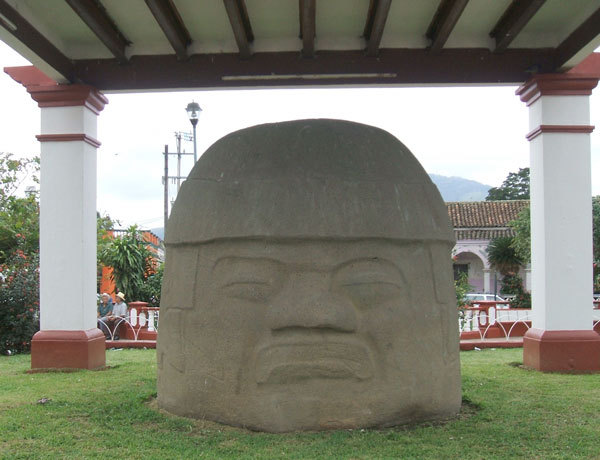The Formative Period begins with the first appearance of pottery and ends with the rise of the Teotihuacan and Mayan civilizations. It was an epoch marked by the emergence of effective agriculture, the establishment of human settlements and the development of fundamental arts.
The earliest site of the period discovered so far is Chiapa de Corzo, located in the Grijalva Depression of Chiapas and estimated to have been inhabited between 1500 and 100 BC. The oldest recorded Mesoamerican date, equivalent to 36 BC, is believed to be that of Stela 2 found here. Among other sites of great antiquity (c. 1000-300 BC) are El Arbolillo, Zacatenco, Tlatilco and Cuicuilco in the Valley of Mexico, and Chupicuaro in the state of Guanajuato.

The first significant civilization to develop in Mesoamerica was that of the Olmecs. Considered by some to be the mother culture of pre-Hispanic Mexico, the “rubber people” venerated the jaguar as supernatural. Olmec artifacts bearing images of the were-jaguar, distinguished by the combined physical characteristics of humans and felines, have been found scattered throughout Mexico. The remains of their ceremonial centers are found in the humid lowlands near the Gulf Coast in the states of Veracruz and Tabasco.
San Lorenzo, the collective name of three related sites in the Coatzacoalcos River basin, was an important Olmec political-religious center that flourished between 1200 and 900 BC. It is noted for the discovery of the first conduit drainage system known in the Americas and six colossal basalt heads each measuring eight to nine feet in height and weighing 20-40 tons. Carved from stone obtained 50 miles or more from the site, these uniquely Olmec monoliths have strikingly Negroid facial features and appear to be wearing helmets. Archaeologists discovered the first Olmec head at Tres Zapotes where they also found Stela C, bearing the long count date 31 BC.
More gigantic Olmec heads, along with a number of massive stone altars and stelae, were found at La Venta, the culture’s most important center. Presumably the stone works were somehow floated via waterways to La Venta, located on an island near the Gulf Coast. Sharing essential characteristics of all later Mesoamerican centers, the site is laid out along a north-south axis, with a huge clay and earth pyramid its most prominent feature. The center appears to have been deliberately destroyed around 400-300 BC.
The Olmecs were apparently the first Mesoamerican people to fathom the concept of zero, develop a calendar, and create a hieroglyphic writing system. These intellectual achievements, along with Olmec myths and rituals, were influential in the subsequent Maya, Zapotec, Mixtec and Aztec cultures.

Why did they make the gigantic stone heads? Was it a religious thing?
Hi Grace, Great question! Relatively little is known for sure about the Olmecs. The difficulty of carving huge stone heads suggests that a religious motive of some kind might well have been the main reason (but there are other possibilities). Editor
What was the Olmec’s greatest achievement?
The monumental stone heads they made? Their calendar? Their writing system? All of the above?
Why did they make the gigantic stone heads? Was it a religious thing?
Perhaps, but I don’t think anyone really knows the reason or reasons. They must have had some good reason given the amount of work involved!